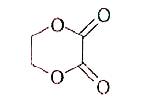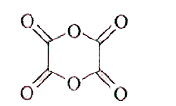When acetylene is passed through dil. H2SO4 in the presence of HgSO4, the compound formed is
Acetic acid
Ketone
Ether
Acetaldehyde
The correct Answer is:4
To determine the compound formed when acetylene (C₂H₂) is passed through dilute H₂SO₄ in the presence of HgSO₄, we can follow these steps:
Step 1: Identify the Reactants
The reactants in this reaction are:
- Acetylene (C₂H₂)
- Dilute sulfuric acid (H₂SO₄)
- Mercury(II) sulfate (HgSO₄)
Step 2: Understand the Reaction Mechanism
This reaction is known as the oxymercuration-demercuration reaction. In this process, the acetylene undergoes hydration in the presence of HgSO₄, which facilitates the addition of water (H₂O) across the triple bond of acetylene.
Step 3: Addition of Water
When acetylene reacts with dilute H₂SO₄ and HgSO₄, water is added across the triple bond. The reaction can be represented as follows:
C2H2+H2SO4HgSO4−−−−→CH2=CH-OH
This intermediate product is known as vinyl alcohol (or enol).
Step 4: Rearrangement to Form Aldehyde
The vinyl alcohol (CH₂=CH-OH) is unstable and undergoes tautomerization to form acetaldehyde (CH₃CHO). The rearrangement involves the migration of the hydrogen atom and the conversion of the double bond:
CH2=CH-OH→CH3CHO
This results in the formation of acetaldehyde.
Step 5: Conclusion
Thus, the compound formed when acetylene is passed through dilute H₂SO₄ in the presence of HgSO₄ is acetaldehyde (CH₃CHO).
Final Answer:
The compound formed is acetaldehyde (CH₃CHO).
---
The reactants in this reaction are:
- Acetylene (C₂H₂)
- Dilute sulfuric acid (H₂SO₄)
- Mercury(II) sulfate (HgSO₄)
This reaction is known as the oxymercuration-demercuration reaction. In this process, the acetylene undergoes hydration in the presence of HgSO₄, which facilitates the addition of water (H₂O) across the triple bond of acetylene.
When acetylene reacts with dilute H₂SO₄ and HgSO₄, water is added across the triple bond. The reaction can be represented as follows:
C2H2+H2SO4HgSO4−−−−→CH2=CH-OH
This intermediate product is known as vinyl alcohol (or enol).
The vinyl alcohol (CH₂=CH-OH) is unstable and undergoes tautomerization to form acetaldehyde (CH₃CHO). The rearrangement involves the migration of the hydrogen atom and the conversion of the double bond:
CH2=CH-OH→CH3CHO
This results in the formation of acetaldehyde.
Thus, the compound formed when acetylene is passed through dilute H₂SO₄ in the presence of HgSO₄ is acetaldehyde (CH₃CHO).
The compound formed is acetaldehyde (CH₃CHO).
Topper's Solved these Questions
- HYDROCARBONSBOOK - AAKASH INSTITUTE ENGLISHCHAPTER - HYDROCARBONSEXERCISE - Assignment(Section - B) (Obejctive type question)
5 Videos
- HALOALKANES AND HALOARENES BOOK - AAKASH INSTITUTE ENGLISHCHAPTER - HALOALKANES AND HALOARENES EXERCISE - ASSIGNMENT SECTION -D
15 Videos
- HYDROGENBOOK - AAKASH INSTITUTE ENGLISHCHAPTER - HYDROGENEXERCISE - ASSIGNMENT (SECTION - D) (Assertion-Reason Type question)
15 Videos
Similar Questions
Knowledge Check
When ethylene glycol is heated with oxalic acid in the presence of conc. H2SO4, the product formed is :
A B
B C
C D
D
Find the product when Phenyl acetylene reacts with dil. H2SO4 in presence of HgSO4
View SolutionAn alcohol A, when heated with conc. H2SO4 gives an alkene B. When B is bubbled through bromine water and the product obtained is dehydrohalogenated with exccess of sodamide, a new compound C is obtained. The compound C gives D when treated with warm dilute H2SO4 in the presence of HgSO4. D can also be obtained either byh oxidising A with KMnO4 or form acetic acid through its calcium salt. Identify A, B, C, and D.
View SolutionWhen SO2 is passed through a solution of H2S in water :
View SolutionA hydrocarbon (A) containing 90% carbon and having V.D. 20 reacts with dil. H2SO4 in the presence of H2SO4 to give (B). Compound (B) is reduced by LiAIH4 to (C) which on heating with H2SO4 gives (D). Compound (A) can be converted into (D) directly by hydrogenation in the presence of deactivated palladium-calcium carbonate catalyst. Identity the compounds (A) to (D) and explain the reactions involved.
View SolutionWhat happens when a sulphite reacts with dilute H2SO4 in presence of zinc ?
View SolutionChlorobenzene reacts with trichloro acetaldehyde in the presence of H2SO4

The major product formed is :
View SolutionCompound 'A' is prepared by oxidation of compound 'B' with alkaline KMnO4. Compound 'A' on reduction with lithium aluminium hydride gets converted back to compound 'B'. When compound 'A' is heated with compound 'B' in the presence of H2SO4, it produces fruity smell of compound 'C'. To which family, the compounds 'A', 'B' and 'C' belong to ?
View Solution
